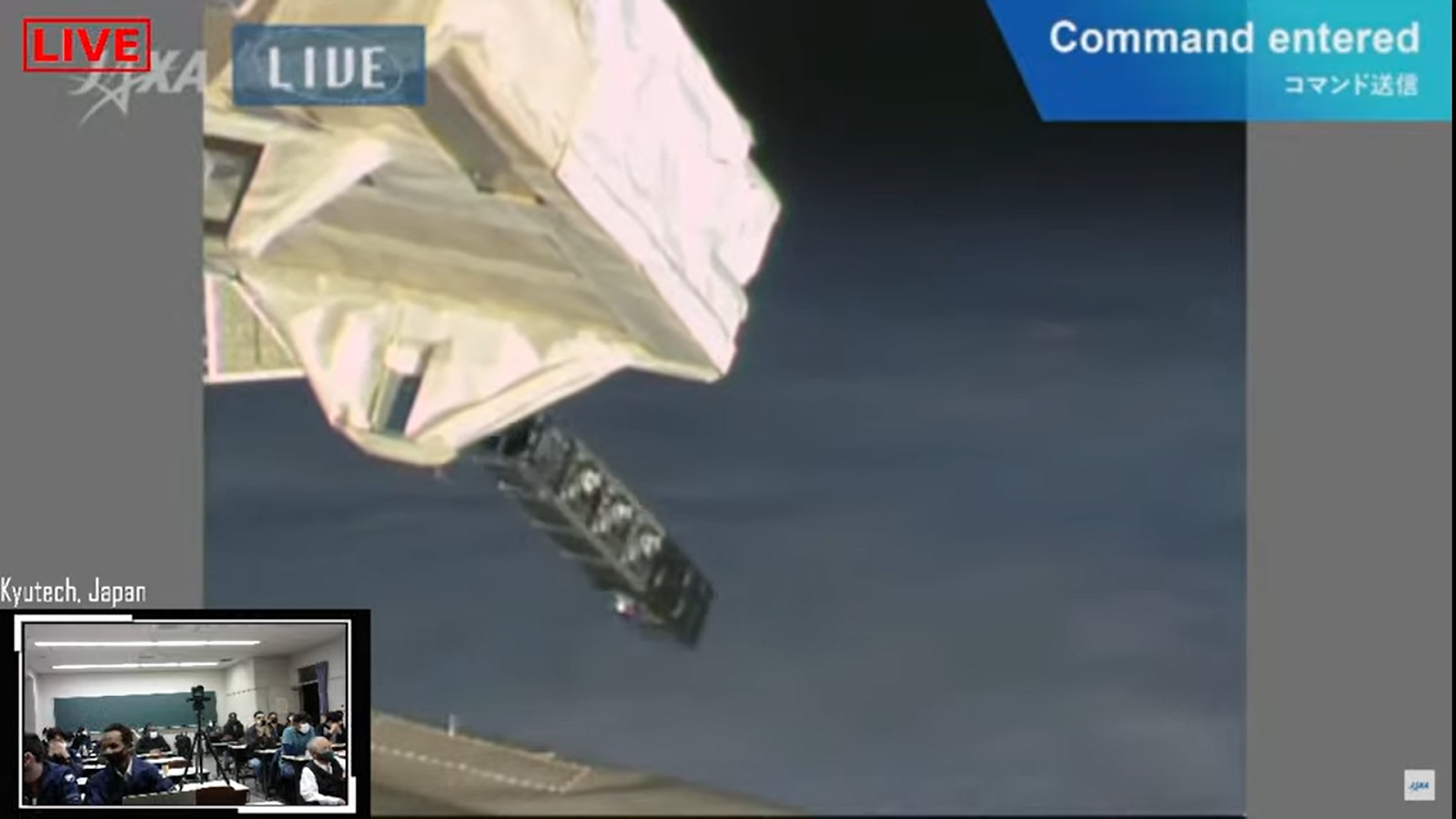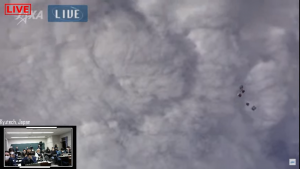
Screenshots of the BIRDS-4 CubeSats being deployed from the ISS. Captured from the JAXA livestream
.
The Philippines’ newest satellite has taken flight and is ready to take on its mission.
Maya-2, a cube satellite (CubeSat) made by Filipino engineers studying in Japan, was released to space from the International Space Station (ISS) on March 14, 2021 at around 7:20 p.m. PHT. This latest development follows the CubeSat’s launch to the space station aboard a Cygnus NG-15 rocket (S.S. Katherine Johnson) on February 21, 2021, together with CubeSats Tsuru (Japan) and GuaraniSat-1 (Paraguay).
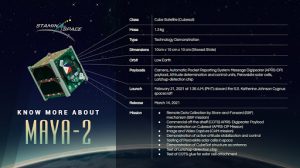
Maya-2 fast facts
The three satellites were designed and developed under the 4th Joint Global Multi-Nation Birds Satellite (BIRDS-4) Project of the Kyushu Institute of Technology (Kyutech) in Japan. Their primary purpose is technology demonstration, from which the learnings will be used as an educational platform. The three Filipino engineers were sent to Kyutech by the Department of Science and Technology’s Science Education Institute (DOST-SEI) to pursue doctoral degrees as part of a scholarship program done in cooperation with the Space Science and Technology Proliferation through University Partnerships (STeP-UP) Project of the STAMINA4Space Program. Like its predecessor Maya-1 (decommissioned on November 23, 2020), Maya-2 can remotely collect data using a Store-and-Forward (S&F) mechanism and capture images and videos using an on-board camera. Its 1.3 kg frame is also equipped with an Automatic Packet Reporting System Message Digipeater (APRS-DP), attitude determination and control units for active attitude stabilization and control demonstrations, Perovskite solar cells, and a Latchup-detection chip.
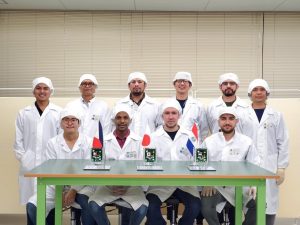
BIRDS-4 engineers with the BIRDS-4 satellites. Back (Left to Right: Mark Angelo Cabrera Purio (Philippines), Izrael Bautista (Philippines), Hari Ram Shrestha (Nepal),Yuma Nozaki (Japan), Anibal Mendoza (Paraguay), Marloun Sejera (Philippines)
Front (Left to Right): Daisuke Nakayama 中山大輔 (Japan), Yasir Abbas (Sudan), Adolfo Javier Jara Cespedes (Paraguay), Yiğit Çay (Turkey). Photo courtesy of the BIRDS-4 Project.
What’s next for Maya-2 now that it is in space?
“Right now we hope to execute all our missions with the help of other BIRDS ground stations around the world so that we could utilize the satellites to their full extent,” said BIRDS-4 Project Manager Izrael Zenar Bautista. Maya-2 engineer Marloun Sejera adds that the team is now preparing for the satellite operation, which includes satellite health monitoring and mission execution.
With Maya-2 being the Philippines’ fourth successful attempt to send a satellite to space in collaboration with Japan, this new milestone continues to nurture the longstanding partnership between the two nations.
“As the principal investigator of the BIRDS program, I am very happy to see Maya-2 deployed from the ISS,” said BIRDS Project Principal Investigator Dr. Mengu Cho, who highlighted the BIRDS Project’s goal to foster human resources to initiate indigenous space programs in non-space faring countries. “After seeing the infant space programs in many countries, I can say that the Philippines is one of the best examples of a success story… for Maya-2, three students from the Philippines are engaged and play key roles in the entire BIRDS-4 project. I am sure that they can be an important asset to the future Philippine space program. So far, I have supervised five Philippine students under the BIRDS program and have been always satisfied with their talents and sincereness to study.”
Kyutech Assistant Professor George Maeda shares the same sentiments.
“Of all the BIRDS partners, none is more serious about developing in-country ‘human resources’ than the Philippines. Before you can make a spacecraft, you have to train engineers who know how to make them. The point is understood in your country,” said Prof. Maeda. He adds, “And one more thing that is immensely impressive, you have propagated more capacity building through BIRDS-2S and BIRDS-4S [locally developed cubesats under the nanosatellite engineering track in EEEI UPD]. This means the ‘BIRDS concept’ is replicated inside of the Philippines. The fruit of knowledge acquired at Kyutech is taken to the Philippines and then applied to help others—this ‘multiplication of knowledge’ is precisely what we want to occur. This is what education is all about. It means to spread knowledge. Replace darkness with light on a broad scale.”
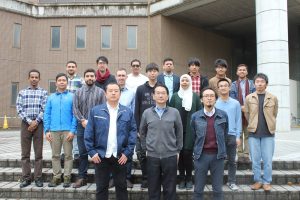
Kyutech BIRDS-4 Team. Back (Left to Right): Yiğit Çay (Turkey), Yuma Nozaki (Japan), Izrael Bautista (Philippines), Hari Ram Shrestha (Nepal), Tomoaki Murase (Japan), Daisuke Nakayama 中山大輔 (Japan), Mark Angelo Cabrera Purio (Philippines)
Mid (Left to Right): Yasir Abbas (Sudan), Marloun Sejera (Philippines), Anibal Mendoza (Paraguay), Adolfo Javier Jara Cespedes (Paraguay), Hiroki Hisatsugu (Japan), Hoda Awny (Egypt), Timothy Leong (France), Dr. Takashi Yamauchi (Researcher, KyuTech)
Front (Left to Right):Dr. Sangkyun Kim (Assistant Professor, KyuTech), Prof. Cho Mengu (Professor, KyuTech / Principal Investigator, BIRDS Project). Dr. Hirokazi Masui (Assistant Professor, KyuTech). Photo courtesy of Prof. George Maeda.
After the scholars complete their studies, they have their eyes set on furthering the proliferation of the knowledge they gained in Japan and bring it back to the Philippines.
“After finishing my studies, the plan is to return to our respective institutions and carry out knowledge transfer to aspiring students in the field of science and technology,” said Marloun Sejera.
Maya-2 engineer Mark Angelo Purio chimes that he also plans on returning to his alma mater, Adamson University, to impart what he learned in Japan after he completes his PhD degree and supporting government projects related to this endeavor. “Furthermore, I envision setting up our own ground station in the university to continue our efforts to support space-related activities while involving our students by providing them hands-on training.”
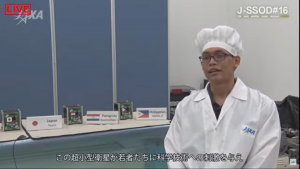
BIRDS-4 Project Manager Izrael Bautista
As for Izrael Zenar Bautista, he hopes to contribute to the growing space industry back home.
“Maybe in the Philippine Space Agency or in the academe so that I could share the things I learned in Kyutech and apply it for the future satellites that our country will build. A startup relating to satellites or my research is also one that I’m looking into,” he says. He also shared that he plans to continue what he has learned in Japan, from his research in Perovskite solar cells to satellite systems engineering, to hopefully providing meaningful output for the Philippines.
The investment made in these scholarships are well worth it, according to DOST-SEI Director Dr. Josette T. Biyo.
“We are ecstatic over Maya-2’s successful deployment to space and incredibly proud of the DOST-SEI STeP-UP scholar-engineers behind it,” she says. “They exemplify the perseverance of Filipinos and the brilliance of our science scholars. Maya-2 proves that the country’s space program and science scholarships are investments worthy of people’s support.”
“The successful launching of Maya-2 makes me feel proud,” said DOST Secretary Fortunato de la Peña. “The accomplishment made possible by our young researchers and engineers should make us confident that we can do more in the area of space technology. I have high hopes that we as a people will be able to benefit more from developments in this area—all towards making the quality of life of our people better.”
As early as now, the Philippines can bank on witnessing more satellites be sent to space in the near future—with Maya-3, Maya-4, Maya-5, and Maya-6 already in their respective development and testing phases.
“Between Japan and the Philippines, there are other ongoing space-related collaborations, including STAMINA4Space Program,” said Prof. Mengu Cho. “I am very happy to see [that the] Philippines is engaged in Maya-3 to Maya-6 projects to build CubeSats domestically. These kinds of capacity building efforts will solidify the basis of the Philippine space program. I am certain that the deployment of Maya-2 will open another page of our collaboration.”
Philippine Space Agency (PhilSA) Director General Dr. Joel Marciano, Jr. issued the following statement, “Just as how computers on Earth have helped to improve our lives, satellites like Maya-2 are ‘computers in orbit’ that work for us from space. With the release of Maya-2 from the ISS, the genius words of Mark Weiser, father of ubiquitous computing, resonate with renewed meaning and inspiration: ‘The most profound technologies are those that disappear. They weave themselves into the fabric of everyday life until they are indistinguishable from it’. Like Diwata-1, Maya-1 and Diwata-2 before it, Maya-2 now ‘blends’ into the background to serve and perform its mission. Godspeed, Maya-2!”.
Please stay tuned for official updates about the initial contact between the CubeSats and the ground station.




